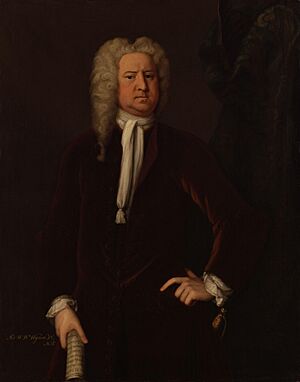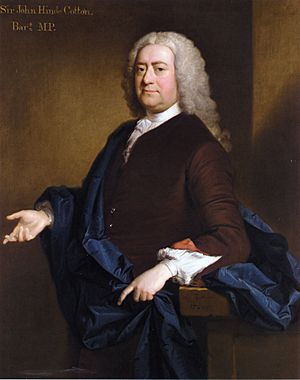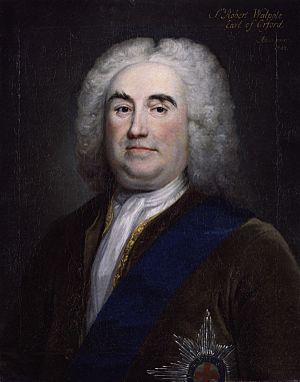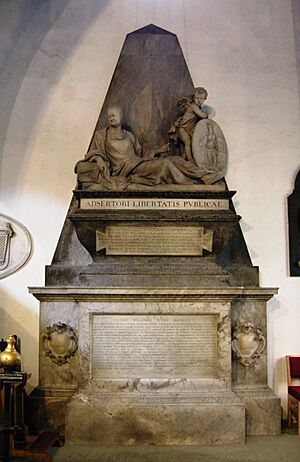Sir Watkin Williams-Wynn, 3rd Baronet facts for kids
Quick facts for kids
Sir Watkin Williams-Wynn, Bt
|
|
|---|---|
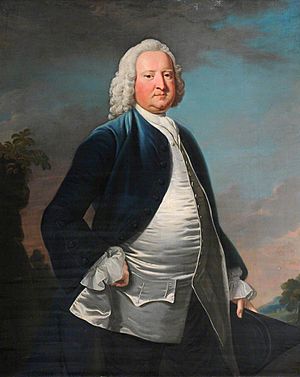 |
|
| MP for Denbighshire | |
| In office 30 June 1716 – 1741 |
|
| MP for Montgomeryshire | |
| In office 1741 – 23 February 1742 |
|
| MP for Denbighshire | |
| In office 23 February 1742 – 20 September 1749 |
|
| Mayor of Oswestry | |
| In office 29 September 1728 – 28 September 1729 |
|
| Mayor of Chester | |
| In office 29 September 1732 – 28 September 1733 |
|
| Personal details | |
| Born | 1692 Llanforda, near Oswestry |
| Died | 20 September 1749 (aged 57) Ruabon |
| Resting place | St Mary's, Ruabon |
| Political party | Tory |
| Spouses | (1) Anne Vaughan, 1715 – 1748 (2) Frances Shakerley, July 1748 |
| Children | John Williams Wynn (1716 – died young) Mary Williams (1717–1735) Sir Watkin Williams-Wynn, 4th Baronet (1748–1789) |
| Parents | Sir William Williams, 2nd Baronet Jane Thelwall |
| Residence | Wynnstay |
| Alma mater | Jesus College, Oxford |
| Occupation | Landowner and politician |
Sir Watkin Williams-Wynn, 3rd Baronet (born around 1692, died September 26, 1749) was an important Welsh politician and a very wealthy landowner. He served as a Member of Parliament (MP) in the British House of Commons from 1716 until he died in 1749. He was a member of the Tory party and also supported the Jacobites. Jacobites were people who wanted the old royal family, the Stuarts, to return to the throne instead of the new Hanoverian kings. Sir Watkin helped remove Prime Minister Robert Walpole from power in 1742. He also talked with the exiled Stuart family before the 1745 rebellion, but he did not join the fight himself. He died in a hunting accident in 1749.
Life of Sir Watkin Williams-Wynn
Sir Watkin Williams-Wynn was the oldest son of Sir William Williams, 2nd Baronet. His family lived in Llanforda, near Oswestry in Shropshire. His mother was Jane Thelwall. His grandfather, also named Sir William Williams, was a top lawyer for King James II.
In 1719, Sir Watkin inherited the large Wynnstay estates from a relative, Sir John Wynn. He had to add "Wynn" to his name to get these lands. When his father died in 1740, he also inherited his father's title and lands.
Sir Watkin became one of the most powerful landowners in North Wales. This was partly because of his first wife, Ann Vaughan (who lived from about 1695 to 1748). She brought him many more estates in Montgomeryshire and Denbighshire. After Anne died in 1748, he married Frances Shackerley (1721–1803). His son and heir, Sir Watkin Williams-Wynn, 4th Baronet (1749–1789), was born just a few months before Sir Watkin's death.
Political Career and Influence
After studying at Jesus College, Oxford, Sir Watkin Williams-Wynn became a Member of Parliament (MP) for Denbighshire in 1716. His first speech in Parliament was in 1727. He was a very active member of the Tory party, especially the group that supported the Jacobites.
Sir Watkin was a leader of a Welsh Jacobite group called the Cycle of the White Rose. This group supported the return of the Stuart kings. He even caused some trouble during the 1722 election by "burning the King's picture." He also disagreed with showing loyalty to King George I after a plot against him in 1722.
Besides being an MP, he also served as Mayor of Oswestry from 1728 to 1729. Later, he was Mayor of Chester from 1736 to 1737.
Sir Watkin's wealth and connections made him very powerful in local politics. In 1722, nine out of eleven Parliamentary seats in North Wales were won by Tory candidates. However, the Whig party, led by Robert Walpole, was still in control of the government. Because the Tories were kept out of power, many of them, especially the more extreme ones, continued to show Jacobite support. Sir Watkin even used Welsh coal miners to threaten Whig supporters during the 1733 Chester mayoral election.
Jacobite support was sometimes complicated. For example, in 1736, Sir Watkin and other Tory Jacobites voted against removing laws that restricted people who were not part of the Church of England. These included Nonconformists and Catholics, like the exiled Stuarts. Many people in Wales strongly opposed religious minorities because of past conflicts.
When the Tory leader Sir William Wyndham died in 1740, Sir Watkin led the effort to remove Prime Minister Walpole. He worked with Sir John Hynde Cotton, who was known as a strong Jacobite. Cotton was a great speaker and helped organize the campaign against Walpole in Parliament.
In the 1741 election, Walpole tried to stop Sir Watkin from winning his Denbighshire seat. Even though Sir Watkin won more votes, many of them were not counted, so his rival won. He then became MP for Montgomeryshire instead. After Walpole resigned in 1742, Sir Watkin successfully appealed and got his Denbighshire seat back.
However, the main winners from Walpole's fall were other groups, not the Jacobites. This led Jacobites like Sir Watkin and the 4th Duke of Beaufort to restart talks with agents of the Stuart family.
In 1744, Sir Watkin voted with the government for the first time. This happened when Cotton accepted a government job. Even though Britain and France were fighting in the War of the Austrian Succession, Sir Watkin secretly went to Versailles in France in October 1744. There, King Louis XV promised him that France would support a Jacobite uprising.
Like many other Jacobites, Sir Watkin's support depended on a large French army landing in England. When Prince Charles Stuart invaded England during the 1745 Rebellion, Sir Watkin stayed in London to attend Parliament. He only sent a message promising help if a French army arrived, but this offer came too late for Prince Charles.
After the rebellion ended, a former secretary of Prince Charles, Murray of Broughton, gave evidence that led to the execution of Lord Lovat. He also mentioned several Tories, including Sir Watkin and Cotton. However, the government decided not to prosecute them further.
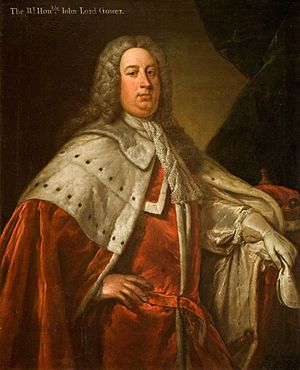
The Tory party was now split into a "Jacobite" group led by Sir Watkin and another group that followed Lord Gower. To gain support, Sir Watkin and others took part in Jacobite demonstrations at the 1747 Lichfield Races. Despite these efforts, the 1747 election greatly reduced the number of Jacobite Tories in Parliament.
Even though he didn't join the 1745 rebellion, Sir Watkin wrote to Prince Charles in December 1747. He told the Prince that his supporters wished for another chance to help him. It was common for people to say one thing and do another. For example, Cotton urged King Louis XV to invade in August 1745, even though he was a government minister at the time.
The demonstration at Lichfield was one of the last big displays of Jacobite support. However, Sir Watkin's son, the 4th Baronet, restarted the White Rose Cycle in 1770. It became a club for people with different ideas.
Legacy and Impact
Sir Watkin Williams-Wynn was buried at Ruabon in St Mary's parish church. His wife, Dame Frances, asked the sculptor Michael Rysbrack to create a monument for him, which was finished in 1755. It was so big that a new chapel had to be built to hold it.
He also ordered the building of a new mansion at Wynnstay. The original house, built in 1616, was later destroyed by fire in 1858. When he died, his estates covered five Welsh counties and part of Shropshire in England. It was said that these lands brought in about £20,000 a year in rent, which was a huge amount of money back then. However, it was also rumored that his political activities left his son with debts of over £120,000.
Sir Watkin Williams-Wynn left some items to Jesus College, Oxford. One of these was a huge silver-gilt punch bowl. It weighed more than 200 ounces (about 5.7 kg) and could hold 10 imperial gallons (about 45 liters) of liquid. This bowl was used at a dinner in 1814 to celebrate the defeat of Napoleon. Many important people attended, including the Tsar of Russia, the King of Prussia, and the Duke of Wellington.
A portrait of Sir Watkin Williams-Wynn by Thomas Hudson was bought by Jesus College in 1997. It hangs in the Senior Common Room and is not usually shown to the public. In the portrait, he is wearing a sky-blue coat, which was a symbol used by Tory Jacobite supporters.



